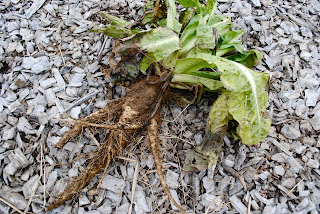
It's striking that the first emanation of new life here on the farm, in this new year, is the energy of this root. Endive is a curious vegetable.
We planted the better part of one whole bed in our garden to endive seed in the early Spring. They sprouted uniformly and grew with vigor. In the row they looked like gigantic dandelions, albeit lacking the dandelion's other defining features - the glorious yellow flower forming those weightless, reproductive orbs. Summer turned over into Fall, and they remained in place. We let them weather a few hard frosts before harvesting the roots. This encourages them to sprout readily when the time is right.


The Bubels, in their book Root Cellaring, suggest that any root larger than 1" in diameter will yield a tender top when forced . We found our roots had outdone themselves - many of them measuring 2.5 -3" at the head.

Garth dug each plant, removed the withering foliage, and packed the roots into used feed bags with some moist sand. The stuffed bags were placed next to our cage of root vegetables on the dirt floor of our basement. No, the root cellar didn't make the cut last year, so our winter storage is fumbling along below us (it's a little too warm and bright down there to be ideal).


About six weeks before we anticipated wanting fresh greens in winter, we began forcing them. Oh the relentless calender! Garth brought down his five gallon beer brewing bucket from the top of the hops barn. It has holes all through the bottom - adequate drainage. I packed 10 roots in together, cheek by jowl, and filled in the remaining spaces with sand. All the necessary energy is right there in the root, so the medium it's forced in doesn't matter at all. Thankfully Garth had just swept up a summer's worth of activity in the wood shop, just as I was looking for saw dust (from not pressure treated lumber). I moistened the wood shavings and filled the bucket to the brim. In the presence of light, endive will become excessively bitter. I put some wet newspaper over the top and stuck this whole contraption under the desk in the living room. A steady temperature of 50-60 degrees F is ideal for forcing endive.

We kept an eye on them, moistening the wood shavings every week or so, until a pale leaf appeared at the surface. It was kind of a touchy job - heaving handful after handful of musty saw dust into a second bucket, searching for the base of the plant with a knife, all the while trying not to harm its tender shoot. They emerged measuring between 4 and 6 inches. The saw dust came off quite easily under the faucet. I cut a piece of irish bacon into small cubes and browned it with a bay leaf. I then removed the pork and sauteed the chopped endive in the warm pan, adding the bacon pieces back into the mix when the leaves had just softened. We enjoyed this in the company of two other farmers who had stopped in for a night and morning. Staring out the window at the blowing snow -it was a wonderful way to appreciate a winter.
- Alanna

No comments:
Post a Comment